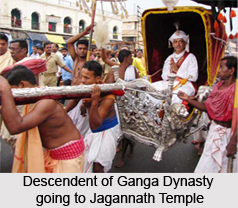 Temple rituals of Kings are an important function of the Lord Jagannath. In the absence of other functionaries and in case of emergencies the king is entitled to perform all ritual services except cooking and offering of food to the Images. He has the right to appointment of ritual functionaries and disposal of offices falling vacant by death and other causes. He is entitled to punish the functionaries for their negligence of and deviation from the prescribed duties. He has also powers of management, supervision and control of the temple affairs. The king pays great attention to the education of the sons of the functionaries who would succeed their father`s ritual duties in the temple. The kings have also entrusted some monasteries such as Sankaracharya monastery at Puri with the task of imparting ritual instructions to the sons of the functionaries and make them fit to perform their respective duties at the temple. A ceremony called Sadibandha is performed on the occasion of bestowal of the king`s approval of appointment of a new ritual functionary to the temple service.
Temple rituals of Kings are an important function of the Lord Jagannath. In the absence of other functionaries and in case of emergencies the king is entitled to perform all ritual services except cooking and offering of food to the Images. He has the right to appointment of ritual functionaries and disposal of offices falling vacant by death and other causes. He is entitled to punish the functionaries for their negligence of and deviation from the prescribed duties. He has also powers of management, supervision and control of the temple affairs. The king pays great attention to the education of the sons of the functionaries who would succeed their father`s ritual duties in the temple. The kings have also entrusted some monasteries such as Sankaracharya monastery at Puri with the task of imparting ritual instructions to the sons of the functionaries and make them fit to perform their respective duties at the temple. A ceremony called Sadibandha is performed on the occasion of bestowal of the king`s approval of appointment of a new ritual functionary to the temple service.
The king as the chief functionary of the Lord Jagannath`s temple performs important services on ritual occasions. For instance, he sweeps the three cars with a golden broom at the time of car festival. The custom is called Cherapanhara. He has similar ritual duties during a summer festival and in a winter festival when the Images are covered with royal accoutrement. But in the context of the temple service he is as humble and ordinary as other sebakas are. For all ritual services payment is made in Khei or the foods offered in Kotha bhog. The Khei is divided among all sebakas including the king according to the proportions fixed earlier.
Just as the king considers Lord Jagannath as the divine ruler of Orissa, similarly the king is considered by the public as divine ruler of the State. When the king visits the temple he is served by the ritual functionaries in the same manner as they serve Lord Jagannath.
The king goes to the temple in palanquin with cymbals, ritual parasol, and bugles. He is received at the Lion`s gate by one of the functionaries from the supervising staff, as well as other categories of ritual functionaries. Then the party of functionaries escort him inside the temple in a procession. While the king is present in the temple different functionaries perform their respective duties in his honour.
People as a mark of honour and respect to the king place pitchers full of water before their doors, plant plantain trees in front of their houses and hang garlands of mango leaves at various places. The tributary chiefs of feudatory states of Orissa who are subordinate to the paramount king act also as functionaries to the king on such visits. They perform their respective duties which they are entitled to according to tradition and custom. There are several other ritualistic privileges which are enjoyed exclusively by the king. No one else would dare claim them for fear of penalty of death or disease.
Besides being the chief religious functionary of the temple, the king is in charge of the temple estates and properties endowed in the name of the Lord Jagannath. He keeps accounts of income and expenditure. The king prepares a budget including last year`s total income and expenditure and hands it over to the temple scribe who reads this financial report before the Deputy of the Lord Jagannath on the full moon day in the month of July-August at a particular Shiva Temple in Puri where the deputy god is carried for that purpose.





















